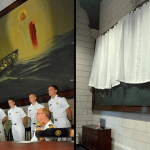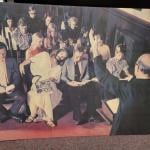Miracle of Sight, by John Frye — whom I want to thank publicly for this series on Mark.
An unusual miracle is reported by Mark (8:2-26) just before Jesus leads his disciples to Caesarea Philippi and asks the burning question of Mark’s Gospel: “Who is Jesus of Nazareth?” (8:27-30).
Ben Witherington III writes, “Very clearly, the miracle recorded in 8:22-26 is meant to be seen in light of the spiritual blindness of the disciples just mentioned. Jesus is the one who opens the eyes of the blind. It is what Hooker calls an acted parable of the miracle of faith” (Mark, 238).
Physical blindness illustrates a blindness of heart and mind about the true identity of Jesus (Mark 8: 27-30). The unusual, two stage healing of the physically blind man—“I see people like trees walking around” (8:24) and “he saw everything clearly” (8:25) is mirrored in the two tiered understanding of Jesus’ identity in the conversation at Caesarea Philippi. Tier one is the peoples’ rumor that Jesus is John the Baptist or one of the prophets (8:28). Tier two is Peter’s clear, accurate declaration “You are the Christ” (8:29). Matthew’s parallel account expands Peter’s confession: “You are the Christ, the Son of the living God” (Matt 16:16).
The recent Oscar-nominated movie, Room, tells the story of an abducted teen girl who is trapped in a shed for seven years. In that time she becomes pregnant by her abductor and has a son. The five year old has known no world other than the confides of the 10’ X 10’ shed. The only portal to the outside world is a skylight. When the boy was very young, the mother lied to him about an outside world; she reduced his reality. At age five, believing that her son might be abused by the abductor, the mother starts telling her son the truth about the outside world. She conceives of a plan to save him and, hopefully, herself as well. The son will have none of it. As she is telling him the story of reality, he yells back at her, “I don’t like this story!”
Jesus came telling a trapped humanity about a wonderful, freeing reality—the kingdom of God. Many people, especially religious leaders, yelled, “We don’t like this reality! We’ve constructed our own!” A Being from another reality was living in our own shed-sized world and telling us about a robustly beautiful and big world. We had no categories for it. So, we crucified him. Like the citizens in H. G. Wells’ 1904 story “The Country of the Blind,” we want to gouge out the seeing eyes of the daring, honest “lunatic” who is describing an alien world to us blind folk.
A few with the help of God did believe in Jesus and did welcome his new kingdom reality. Never popular with the powers that be, this new, subversive reality has been quietly leavening the dough of a fallen world.
Blind eyes are not opened by knowledge, power or status in society. Blind eyes are not healed by money, popularity or theological acumen. How then shall we see? “The god of this age has blinded the minds of unbelievers, so that they cannot see the light of the gospel of the glory of Christ, who is the image of God. For we do not preach ourselves, but Jesus Christ as Lord, and ourselves as your servants for Jesus’ sake” (2 Cor 4:4-5). As Paul writes elsewhere, “I am not ashamed of the gospel, because it is the power of God for the salvation of everyone who believes: first to the Jew, then for the Gentile” (Romans 1:16). Seeing is being saved.
Witherington is correct. “Jesus is the one who opens the eyes of the blind.” Jesus the Christ does it when the good news about who he is and what he’s done is proclaimed.















